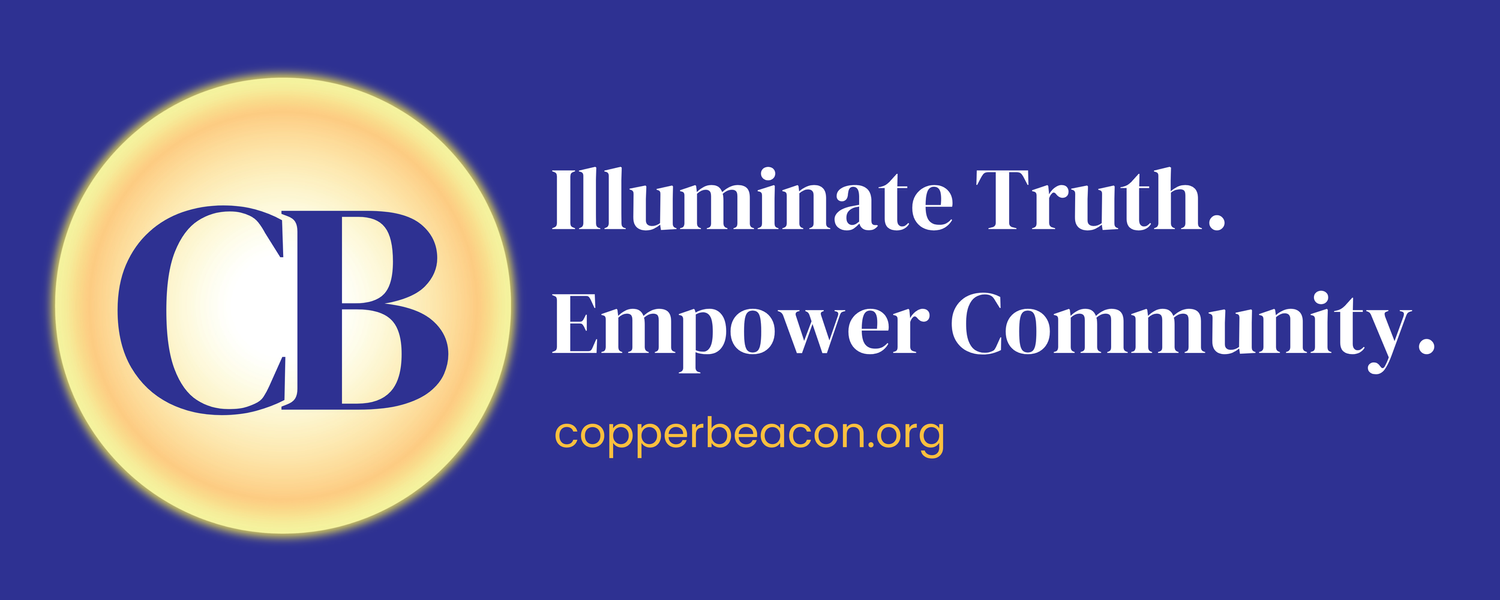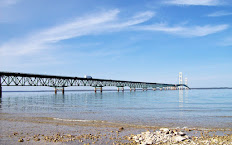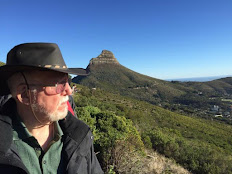With photos by guest photographers
Mountain biker Ben Ciavola rides the "On The Edge" trail along the Brockway Mountain ridge. Click on photo for larger version. (Photo © and courtesy Nathan Miller)
The Keweenaw Outdoor Recreation Coalition (or KORC for short) has attracted public interest from Keweenaw residents and outdoor enthusiasts of all kinds. You may have received a KORC letter in the mail, seen social media content on Facebook or Twitter, or heard about the group’s work at High Rock Bay and Schlatter Lake. So, what is this organization all about?
KORC was founded in 2019 when a coalition of community organizations, local businesses, outdoor recreation interests, and Keweenaw residents came together to pursue a common goal: securing permanent public access to at-risk land in Keweenaw County.
With over 600 members and more than 15 different organizations represented on its steering committee, KORC has united a wide variety of recreation interests and Keweenaw institutions.
"We all decided to get together and develop a coalition to provide for all types of outdoor recreation, where all of the different voices are represented," said Gina Nicholas, a member of KORC’s Steering Committee. "We are working together to keep the land base intact for everyone, so that whether you’re a berry picker or an ATV rider, you have a place to go." Inset photos: At left, a midsummer snack of bilberries along the Copper Harbor Trails. (Photo © and courtesy Devin Leonarduzzi) At right, ORV riders enjoy Keweenaw’s fall color. (Photo © and courtesy Nathan Miller)
a coalition to provide for all types of outdoor recreation, where all of the different voices are represented," said Gina Nicholas, a member of KORC’s Steering Committee. "We are working together to keep the land base intact for everyone, so that whether you’re a berry picker or an ATV rider, you have a place to go." Inset photos: At left, a midsummer snack of bilberries along the Copper Harbor Trails. (Photo © and courtesy Devin Leonarduzzi) At right, ORV riders enjoy Keweenaw’s fall color. (Photo © and courtesy Nathan Miller)KORC’s recreation interests range from self-powered activities like hiking, camping, biking, kayaking, skiing, and snowshoeing, to motorized sports like ATV/ORV riding and snowmobiling. KORC also represents hunting, fishing, berry-picking, and bird watching as well as environmental, geological, historical, and cultural heritage interests. KORC wants to secure permanent public access and provide land use opportunities for all of these varied interests.
KORC Steering Committee member and Eagle Harbor Township Supervisor Rich Probst described the importance of this coordinated effort.
"The biggest thing is the collaboration with all the groups," Probst said. "We are all in this together, getting it done with everybody’s input for the good of the whole."
KORC members are working together to secure land access because much of Keweenaw’s real estate is at risk to fragmentation and loss of public access. Today, a significant portion of the land in Keweenaw County is controlled by an absentee corporate owner.
During the Keweenaw’s copper mining boom in the late 1800s and early 1900s, mining companies amassed ownership of the majority of the land in Keweenaw County. Over time, these companies and the land that they controlled were consolidated under the Calumet and Hecla mining company. But as the industry declined and the mines closed in the latter half of the 20th century, Calumet and Hecla and other mining companies sold off their land.
Since then, this Keweenaw land has changed hands between a string of corporate owners who buy and sell the land as an asset for timber harvest and value appreciation. Today, approximately 120,000 acres of Keweenaw land are owned by the New York based hedge fund complex, The Rohatyn Group (TRG), and overseen by a land management consulting firm called American Forest Management (AFM). Prior to TRG, most of Keweenaw County’s land was owned by another international hedge fund complex, GMO (Grantham, Mayo, Van Otterloo and Co., LLC). GMO is the name that appears in the most recent plat book.

The biggest risk to public access on this land is fragmentation. Hedge funds are almost always ready to sell parts of their holdings for the right price. If pieces of TRG’s holding are sold, and the land is sectioned off into pieces controlled by many private owners, public use may be restricted, trail systems may be forced to re-route or be removed entirely, and Keweenaw residents could lose access to land that they have enjoyed for generations.
Fragmentation is already occurring. In 2000, a forest products company called International Paper owned approximately 175,000 acres of Keweenaw County land. Today, only 120,000 acres of this land are still controlled by a single corporate owner (presently TRG). The difference between these two figures, 55,000 acres of Keweenaw land, has been sectioned off and sold by hedge fund owners over the past two decades. While some of this land was purchased by local conservancies and units of government and is still open to the public, some prime lakeshore properties and other desirable areas have been sold to private owners and are now developed or inaccessible to the public.

"We had the privilege for almost 100 years of using this land that we didn’t own and we didn’t pay taxes on -- we just used it because the owners didn’t care," Nicholas noted. "But it wasn’t a right; it was always a privilege. We can’t rely on privileges any longer. We have to find a way to secure access in a legal and respectful manner."
Working with Michigan DNR
KORC hopes to secure this access by collaborating with the State of Michigan to help manage existing State land and to assist the State in acquiring more Keweenaw County land.
In 2002-2003, the State of Michigan purchased roughly 6,300 acres of land on the tip of Keweenaw using money from the Michigan Natural Resources Trust Fund. The initial Tip purchase was made possible with help from The Nature Conservancy (TNC). Over time, TNC, Keweenaw Community Forest Company, and other organizations have helped the Michigan DNR (Department of Natural Resources) add additional parcels and eliminate inholdings. Today the DNR owns 8,999 acres at the Keweenaw Tip and 822 acres at Fort Wilkins.
Dana Richter photographed this view of Manitou Island from High Rock Bay in 2004 during a tour with members of the Keweenaw Point Advisory Committee and DNR staff, following the initial Keweenaw Tip purchase. Remains of a campfire can be seen in the foreground. (Keweenaw Now file photo © 2004 Dana Richter. Reprinted with permission.)In 2005, representatives from the community collaborated with the DNR to produce a management plan for this land. But in the years since, management and stewardship actions have been limited. Visitors to the Keweenaw Tip land are increasingly impeded by poor roads, and they often find these beautiful places damaged by garbage dumping and other misuse.
Community partnerships for management
"The land has huge recreational value and potential, but it is underutilized and undermanaged," noted Aaron Rogers, owner and president of Rock Solid Trail Contracting and a KORC Steering Committee member. "The only way to improve management is with more community involvement. We can do this locally -- not only by advocating for the purchase of more land, but by actively helping to manage it ourselves."
A smiling woman mountain biker heads down one of the Keweenaw's challenging trails. (Photo © and courtesy Nathan Miller)In the spring of 2020, KORC representatives began working together with the DNR to improve public access and clean up this land. KORC and its partner organizations purchased and installed bear-proof trash receptacles at High Rock Bay, and will be funding and constructing a vault toilet to be installed at High Rock in 2021. KORC will provide services for trash collection and vault toilet maintenance by funding partners with local employees.
Trash receptacle installed at High Rock Bay in the summer of 2020. (Photo © and courtesy Gina Nicholas)KORC also raised money to improve the West Schlatter Lake Road. During the summer of 2020, KORC members raised funds to retain Mike McMahon through JE Hendrickson Excavating to repair the road, enabling safer public access for camping and other recreation at Schlatter Lake. KORC also helped Keweenaw County raise money to improve amenities at the Gratiot River Park in Allouez Township.
"I see KORC as a mechanism to allow all the local interest groups to work together to utilize this land," said Mark Ahlborn, Calumet Keweenaw Sportsmen’s Club member and KORC Steering Committee member. "It’s how we are all going to get together to serve everyone who wants to come and visit us."
Businesses and tourism economy
KORC members also believe taking care of Keweenaw’s land and providing positive experiences for visitors are crucial for the local economy. Many of Keweenaw’s restaurants, hotels, shops, and other local businesses depend upon tourism revenue. Visitors are drawn to the Keweenaw for a variety of reasons, from the area’s unique geological features to its mountain biking trails. But these features, and the tourists that they attract, are dependent upon wise management and sustained public access to Keweenaw land.
"Historically we’ve always had it -- it’s always been viewed as a recreational asset for the community, not only for personal use but for tourism and generating tourism dollars for the region," said Rogers. "If it gets sold off and it disappears, it will have a significant impact on tourism and the local economy."
Don Kauppi, KORC Steering Committee member and co-owner of The Mariner North in Copper Harbor, reflected on the economic impact of Keweenaw’s growing tourism industry. Since the 1970s, tourism-based jobs in the Keweenaw have increased dramatically, largely due to outdoor recreational attractions like snowmobiling and biking. Don explains that despite little change in the year-round populations of Houghton and Keweenaw counties, today there are 35 more restaurants in the two-county area than there were in 1978.

Don also described how the recently growing interest in outdoor recreation during all four seasons has extended the months of profitable tourism business in Copper Harbor.
"The terrain is our product," he said. "Now, we’re going to try to save Keweenaw jobs by saving the terrain that brings people up here."
For many KORC members, protecting the local economy means protecting a way of life.
Steering Committee member Jim Vivian III points out that 70 percent of Keweenaw jobs are tourism-based.
"If we lose access to the land, I think it will take decades for our local economy to recalibrate," Vivian said. "It’s to protect our way of life and our economy."
For Keweenaw business owners, promoting the area’s economic vitality goes hand in hand with protecting land and securing public access.
"KORC represents an underlying goal of why I got into business 20 years ago," explained Sam Raymond, Steering Committee member and the owner of Keweenaw Adventure Company. "I thought that trails and outdoor recreation could result in the preservation of the Keweenaw for permanent public access and utilization of all of the wonderful resources that we have. KORC is the vehicle to get us there right now."
Kayaking in blue Lake Superior Waters. (Photo © and courtesy Chris Guibert)KORC seeks public support for State land ownership
KORC is now supporting the DNR’s effort to acquire approximately 15,800 acres of additional land by using the Michigan Natural Resources Trust Fund or other methods to bring this acreage into permanent State ownership. This land includes the actual geographic Keweenaw Point, much of the Mandan road, and portions of the motorized trail system.
If the State purchases this land, it will ensure permanent public access for all to the "Keweenaw Tip Recreation Area." It will secure the main motorized trail corridor ("the rail road grade") from Mohawk to the Tip, and could expand trail systems and other outdoor recreation opportunities. This acquisition would also connect the ecosystems found on the Tip to the larger Keweenaw Coastal Wildlife Corridor by linking the Tip to township and conservancy lands along the Brockway Mountain ridge to Eagle Harbor and Eagle River.
This map shows the potential Keweenaw Tip Recreation Area that State land acquisition would allow. Click on map for larger version. (Map courtesy KORC)KORC is conducting outreach using mailings, email blasts, and social media to raise awareness and gain public support for this project. Additionally, KORC has collaborated with the Keweenaw County Road Commission to collect data on public use of the Mandan Road from the end of US 41 in order to help build the case for land acquisition. KORC encourages anyone who supports this acquisition to submit a nomination form either electronically or through the mail to tell the State why acquiring this land is important.
"Over the years the State never really had the chance to see what we have to offer up here, but now I think that we can prove to them that we are such an asset," said Peg Kauppi, Steering Committee member and co-owner of the Mariner North. "Here we are with this unreal piece of real estate that juts out into Lake Superior. We have so much to offer: the largest vertical drop east of the Rockies, the wildflowers, the rocks, it goes on and on."

"I think that if we don’t take control of this property now so that it can’t be segmented off, then we lose that ability forever," Peg concluded.
KORC and its partners intend to keep working to secure access to Keweenaw land for outdoor recreation, for the local economy, for conservation, for Keweenaw’s cultural heritage. Their hope is that everyone can experience and enjoy this land forever. Gina Nicholas expressed this wish for future generations.
"I’ve always loved Keweenaw, and I want my child and my future grandchildren to have the same thing that I feel is one of the most important things in my life," Nicholas said. "I have to fight for posterity."
Aaron Rogers noted his belief that everyone who has a life in the Keweenaw region can support the KORC mission of securing public access to this land.
"I would encourage people -- if they have any questions about KORC, its mission, and what it stands for -- to reach out and gain an understanding of what we are trying to do," Rogers said. "All of our communities stand to benefit from what KORC is doing."
More information on KORC and its initiatives can be found on the KORC Website, and on KORC’s Facebook, Instagram, and Twitter pages. KORC encourages interested individuals to become members and support the group’s efforts to secure permanent public access to Keweenaw land.
* Editor's Note: Keweenaw Now guest writer Nicholas Wilson is a Keweenaw resident and free-lance journalist.































































































































No comments:
Post a Comment